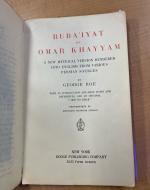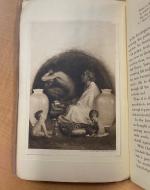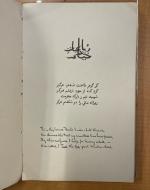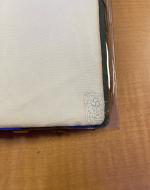Created by aman agah on Mon, 04/17/2023 - 15:38
Description:
The dark suede cover is faded, perhaps once a rich emerald green like the silk pages pressed into the front and back. As if the text has sat out in the sun, and passed through dozens, if not hundreds, of hands. The text is the Rubá’iyat of Omar Khayyam: A New Metrical Version Rendered into English From Various Persian Sources, translated by George Roe. The book jacket displays the title in gold, embossed in a black box, the words surrounded by smoke that rises from a censer. Sadly, part of the title is blocked by the library’s sticker coding the book. The title page includes the following information: “With an introduction and many notes and references and an original ‘Ode to Omar’” (image 1). On the next page, there are two publications dates and places listed, A.C. McClurg & Co., 1906 and Dodge Publishing Company, 1910. The latter also appears on the title page.
There is only one illustration in the text, a “frontispiece” by artist Adelaide Hanscom Leeson (image 2). Leeson, who was born in 1875 in what is now known as Coos Bay, Oregon, was a multimedia artist, including painting and illustration, and her works included a series of photographs illustrating the Rubá’iyat. Photography seems to be the primary medium in which she ultimately created. The image included in this text is richly layered, featuring two small nude children in the foreground, an elderly person in the middle of the image draped in a white cloth, and a naked person crouched over with arms blocking the face in the background. There are two large white vases or pots on each side of the image, a gold goblet near one of the children, and a large bowl of grapes between the children. The elderly person is gazing up, holding a bowl of perhaps incense, with smoke rising, and in front of them are two books, one open. While a specific title is not listed for this image, it certainly depicts various aspects of Khayyam’s poem, including the cycle of life, the often mentioned potter/pots, wine, and what appears to be a sort of longing or questioning as depicted in the elderly person. N
This book is 78 pages in total, and is a translation by George Roe. Roe seems to have offered this text as, at least in part, a response to the translations of FitzGerald, as indicated in his introduction. Roe opens his introduction with “Between those English versions of Omar which sacrifice the letter to the requirements of good verse and those which in order to be literal, sacrifice the spirit of the letter, there is a great gulf. I have attempted a middle course, and the following stanzas are the result.” Roe seeks to demonstrate his knowledge of Khayyam, the Rubá’iyat, and Farsi in this introduction, the full title of the text, and through various other elements present, such as his inclusion of Farsi throughout the text.
Some other unique things about this text, in addition to it being a translation by someone other than FitzGerald and that it includes some Farsi text throughout, include a stanza of the Rubá’iyat in Farsi, then translated below it in English (image 3). Above the stanza, written in calligraphy Farsi, is Rubá’iyat of Omar Khayyam. As you make your way through the poem, you will find some words presented, in the notes of Roe, in Farsi, with the literal translation, providing context and insight into what changes Roe made for the better flow of English; in some cases he has included the transliterated word in his version of the poem. Two unique things about Roe’s text are that he has included his own poem, “An Ode to Omar”, written in English, but in the style of Khayyam (image 4). The second standout of this text is the dedication page. It is dedicated to “My fellow members of The Omar Khayyam Club of America, and especially to Mr. Nathan Haskel Dole, Mr. Charles D. Burrage, and Mr. Eben F. Thompson; This volume is dedicated as a token of gratitude for the kindness and encouragement I have received at their hands.” Finally, there are two little things that make it unique and create a sort of treasure hunt, like the crossed-out price of 75cents to 50cents - indicating the book was perhaps relegated at one point to a used shelf, the price maybe marked down after sitting too long waiting to be purchased. The second is a sticker on the inside of the back cover, it looks almost like a stamp, with circling vines and an emblem of what appear to be three apostrophes, and the words “Paul Elder & Co. San Francisco" (image 5) Paul Elder & Co. was a publishing company from 1898-1968, ran by Paul Elder Sr., then later his son Paul Elder Jr., who sold the company to Brenatno’s, which itself later became Border’s.
Copyright:
Associated Place(s)
Part of Group:
Artist:
- Adelaide Hanscom Leeson






